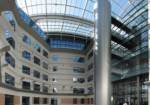This morning I was thinking about a conversation I had last year during my visit to a couple of Universities in Dhaka, Bangladesh. I will never forget what some of the passionate, bright students asked me! Now and then, I keep repeating their questions in my head – how does one change the overwhelming poverty and lack of opportunities that exist in societies like Bangladesh (especially for the next generation, educated students).
Economic survival in today’s highly competitive Knowledge economy of the 21st Century demands a quality education. And perhaps the best way to eradicate poverty is building an economy that creates high-paying jobs for the middle class, educated knowledge workers. It is their discretionary income that uplifts overall economy for any society – does not matter if it is the American heartland, South Asia, the Middle East, Eastern Europe, or the African savanna.
In his book The Post-capitalist Society, business management guru Peter Drucker warned that ‘there is a danger that the post-capitalist society will become a class society unless service workers attain both income and dignity.’ Indeed, the world economy is evolving in the direction in which there are two classes, a prosperous class of knowledge workers and a struggling class of service workers. We see this regardless of whether it’s an advanced or developing society.
As I go through my Sunday surfing for financial and business news around the globe (especially the Asian market), I can’t help but notice the continuous rise of the Taiwan Stock Exchange.
‘Jan. 14 (Bloomberg) — Asian stocks rose, led by Taiwan Semiconductor Manufacturing Co., after a landslide victory by Taiwan’s opposition party in parliamentary elections stoked expectations of improved ties with China. Taiwan Semiconductor, the world’s largest supplier of made- to-order chips, increased the most in more than two weeks. Cathay Financial Holding Co., the island’s biggest financial services company, surged the most in almost five months.
The Weighted Price Index of the Taiwan Stock Exchange rose 255.43 points, or 3.1 percent, to close at 8,428.84, the highest level since Dec. 31, 2007.’
This prompted me to summarize the following data from the Government Information Center of Taiwan (a fascinating success story that continues to grow). It’s an example of a business technology driven knowledge economy that’s creating high paying jobs that’s transforming the entire society.
‘Although Taiwan is a small island with only a short-recorded history, it has miraculously evolved into one of the world’s most advanced nations. In political terms, the island has spent periods under the oppressive rule of five alien regimes over the last four hundred years, during which its inhabitants suffered numerous hardships and tragedies. Nevertheless, the island recently gave birth peacefully to the world’s first Chinese democracy, which is an epochal achievement. In economic terms, from being a primitive and self-sufficient economy, Taiwan began to grow rapidly following Dutch occupation of parts of the island in 1624, and has today transformed into one of the most prosperous, industrialized, hi-tech countries in East Asia. With its many twists and turns, Taiwan’s history is like the story of Cinderella, or “a sparrow transforming into a phoenix” as the Taiwanese say.
To sum up, as a productive island that occupies a key position in East Asia’s sea traffic, Taiwan has thrived in agriculture and commerce, and has created a trade-oriented society. It is little wonder, then, that the Chinese called it a “treasure island.” Following dramatic increases in population after World War II, the island’s economic focus gradually shifted to industry. Today, Taiwan has become an industrialized hi-tech country. They have evolved from Agriculture to Industry (1952-1980), gone through Industrial Growth (1981-1999), and finally developed a Knowledge-based Economy with a thriving middle-class society.
In particular, Taiwan’s electronics and information sectors expanded rapidly to become the island’s mainstream industries, quickly accounting for more output and exports than any other sector in the manufacturing industry. In 1999, 30.4 percent of Taiwan’s exports were electronic, information, and telecommunications products, outpacing the 11.7 percent share held by textile products. Taiwan was the third largest supplier of information hardware products that year after the United States and Japan, and was the world’s number one producer of monitors, motherboards, power supplies, computer cases, scanners, keyboards, mouses, hubs, modems, and network cards.
Taiwan Government’s The Challenge 2008 plan paints a picture to transform it into a green silicon island with humanitarian values, elevate its technological standards, increase its international competitiveness, and create conditions for sustainable economic development. The plan emphasizes culture, creativity, and quality as the foundation for economic development, requires the completion of three major reforms, and focuses on ten investment areas. The ten major investment areas include cultivating talent for the e-generation; developing the cultural creativity industry; developing an international base for research, development, and innovation; increasing high value-added production; doubling the number of tourists visiting Taiwan; developing a digital Taiwan; turning Taiwan into an operations headquarters; improving the transportation infrastructure; conserving water resources and the ecology; and constructing new local communities.’
————————————————————
“The symbol in Chinese for crisis is made up of two ideographs: one means danger, the other means opportunity. This symbol is a reminder that we can choose to turn a crisis into an opportunity or into a negative experience.”
—Anonymous











